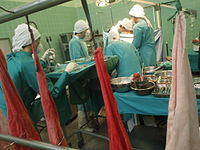
Photo from wikipedia
Purpose of review The current article reviews the rationale, sources and preparation of pig islets for xenotransplantation, and presents current progress in solving the problems associated with establishing pig islet… Click to show full abstract
Purpose of review The current article reviews the rationale, sources and preparation of pig islets for xenotransplantation, and presents current progress in solving the problems associated with establishing pig islet transplant as a clinical treatment for type 1 diabetes. Summary Islet transplantation is an effective treatment option for type 1 diabetes, but the available supply of human pancreases is insufficient to meet the need and demand for obtaining islets. Pig islets provide a readily available source for islet transplantation, with trials in non-human primates demonstrating their potential to reverse diabetes. The risk of zoonosis can be reduced by designated pathogen-free breeding of the donor pigs, but porcine endogenous retroviruses (PERVs) that are integrated into the genome of all pigs are especially difficult to eliminate. However, clinical trials have demonstrated an absence of PERV transmission with a significant reduction in the number of severe hypoglycemic episodes and up to 30% reduction in exogenous insulin doses. A number of methods such as production of various transgenic pigs to better xenotransplantation efficiency and the encapsulation of islets to isolate them from the host immune system are currently being tested to overcome the xenograft immune rejection. Furthermore, ongoing research is also shedding light on factors such as the age and breed of the donor pig to determine the optimal islet quantity and function.
Journal Title: Current Opinion in Organ Transplantation
Year Published: 2017
Link to full text (if available)
Share on Social Media: Sign Up to like & get
recommendations!